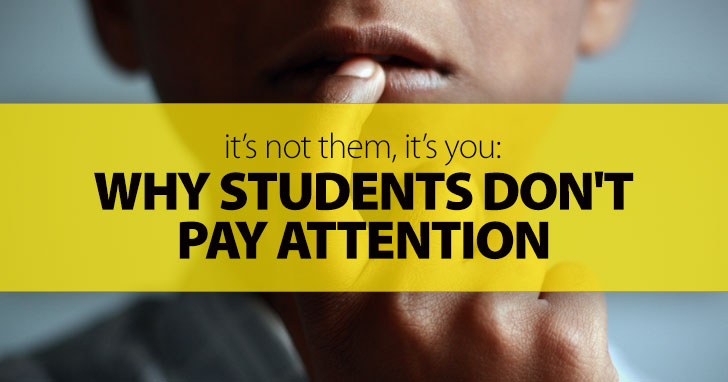
I hate those classes where all I can see is the top of my students’ heads because they’re all looking down at the cellphones in their lap.
Why don’t students pay attention? Is it all this new technology that you just can’t compete with? Is it the fact that kids today just can’t pay attention? Do you need to gamify your classroom? Or did you just get stuck with the worst students in the history of the school?
It’s not them. It’s you. You will run into completely unmotivated students every now and then. But the vast majority of students, like the vast majority of people, get distracted when they get bored. And they get bored when they don’t have anything to do. The key to keeping students focused is keeping them busy and engaged. And to do that, you need to minimize the dead time when they have nothing to do.
While every class is different, there are a few places where dead time often creeps in. It’s often when you are doing some routine classroom task like handing back homework or giving instructions. So here are a few ideas for doing these tasks differently to keep students engaged.

Break the Routine to Keep Learners Engaged
-
1
Beginning of Class
Taking attendance, writing objectives on the board, setting out papers—all these are good chances for students’ attention to wander. And the first minutes of class are a good time to set the stage for an active classroom. One effective way to do that is a Do Now — a puzzle, question or task written on the board that students can do on their own. It could be a review of the topic of the last class, or a warm-up to this class’ grammar lesson. It could be something related to an upcoming holiday or just a quote of the day that students have to ponder and interpret.
If you’re consistent, students will learn to come in, sit down, and start on the task on the board without prompting. In fact, you can start every class with the same routine task, whether it be having students pair up to check homework, take out their reading books and read for ten minutes, or get out their diaries and write about the prompt on the board.
-
2
Giving Instructions
Telling students what to do is my weakest area as a teacher. I’m the student that gets the worksheet or task card and dives right in. I often assume my students are similarly impatient to get going and won’t listen to instructions anyway. But rushing into the activity doesn’t always go well as students who get too confused by a task are liable to stop working. Or do the wrong thing entirely. On the other hand, giving instructions that are too long and detailed invites dead time (and it can be confusing). Thus, it’s important to set a good instruction-giving routine. Make students pay attention—tell them they have to keep their heads up and their eyes on you. Bring in a party noisemaker or something silly to get their attention.
For complicated tasks, give students instructions one at a time. That breaks things up into shorter chunks. Don’t tell students, “Get out a piece of paper, write the ten vocabulary words on it and then underline the ones that end in –er.” Tell students, “Get out a piece of paper” then wait while they do it. Then say, “Write our ten vocabulary words on it,” and let them do it. Then say, “Underline the words that end in -er.” The shorter the chunks of teacher talk time, the less dead time.
-
3
Early Finishers
The problem with early finishers is that they feel they’ve earned the right to slack off because they’re faster than the others. And if you set them the next task, they’ll end up being permanently ahead of the rest of the class as they do everything early.
An easy solution is an extra worksheet or activity. I keep a file of extra work in my classroom. To ensure that they aren’t punished for finishing first, most of the work is fun stuff like brain teasers or riddles or puzzles. Of course, there’s not much motivation in doing busy work, so if I’m giving a task or quiz I think will go quick for some and slow for others, I prepare some kind of review for an upcoming quiz or test—often activities that we didn’t have time for in earlier classes. Or preview questions for the next lesson. They can drill vocab words or write a story using the target piece of grammar. The important point is that the busy work shouldn’t be useless. It should matter to the class.
-
4
Handing Back Assignments
Handing back assignments should go pretty quickly, but I find it’s a landmine of individual questions that alienate the rest of the class: “Teacher, why did I get this one wrong?”, “Teacher, can I give this to you late?”, “Teacher, can I see all my grades?” I’m used to teaching in an Intensive program where neither the students nor I have much time after class or after school to meet. So class time is the only time I have to answer those questions. But as soon as I start to talk to Chen or Ali, those cellphones come right out.
One thing to do is hand out homework while students are busy with something else. You can do it during the Do Now at the beginning of class. That gives them a task they want to do—check their answers—and it cuts down on individual questions. You can also end class with an exit ticket or reflective writing (which is a good idea by itself) and hand out homework while students are doing that. The nice thing about that is it pushes questions to the end of class.
It’s also a good idea to minimize all those questions. You can have students submit homework online either by email or through a class management system like Moodle. There are even websites like Scanmyessay.com that let students hand essays in online AND check them for plagiarism. That way homework is handled outside of class. Alternatively, you can give out the answers with the homework. Sometimes seeing the right answer is enough for students to figure out what they did wrong.
If you’re handing back an essay, you’re probably going to need to conference with students individually. Giving students another assignment is inevitable but I have found that students are still easily distracted because they’re waiting to get their own essay handed back. And you’re not paying full attention to the whole class. One fix it to hand out a model essay for students to study so they can put their own work in perspective. You can even avoid individual conferences by recording your comments online at home. Vocaroo and Voice Thread are two great services that let you easily record your voice I enjoy the chance to speak my comments too instead of writing. It gives my wrist a break and it saves students the torture of reading my handwriting.
-
5
Evaluating Your Own Class
Of course, the best way to figure out where dead time sneaks into your own classroom is to video tape the class, the whole class not just you. Then note the times when students have nothing to do. Note the times when a student looks around, sighs, and pulls out the cell phone. What were you doing? What was the class doing? Why wasn’t he doing anything? Once you know that, you can figure out how to handle the same situation with the whole class engaged. Remember that the best way to prevent dead time is to have a clear consistent plan for how to deal with it.
P.S. If you enjoyed this article, please help spread it by clicking one of those sharing buttons below. And if you are interested in more, you should follow our Facebook page where we share more about creative, non-boring ways to teach English.







